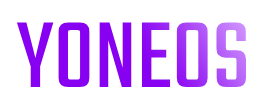Yoneos is a comprehensive project management solution that helps you organize, track, and optimize all your projects, from beginning to end.
Whether you’re a small business or a large organization, Yoneos can help you boost your productivity, collaborate more effectively, and deliver high-quality projects on time and within budget.
In this article, we’ll explore Yoneos’s features and show you how to use it to manage your projects successfully.
1. Introduction to Yoneos and its Features
Yoneos offers a wide range of features to manage all aspects of your projects:
Project Management: Create projects, define tasks, assign resources, track progress, manage budgets, and expenses.
Team Collaboration: Communicate easily with your team, share files, discuss tasks, and collaborate on projects in real time.
Task Management: Create tasks, set deadlines, prioritize tasks, assign tasks to team members, and track progress.
Time Tracking: Track time spent on tasks, manage timesheets, and generate time usage reports.
Invoice Management: Create invoices, track payments, manage balances, and send reminders.
Reporting and Analytics: Gain valuable insights into project progress, team performance, costs, and expenses.
2. Initial Yoneos Setup
Getting started with Yoneos is easy.
Create an Account: Create a free account or a paid account based on your needs.
Configure Your Profile: Add information about your company and team.
Customize Your Dashboard: Define the widgets and information you want to see on your dashboard.
Import Existing Data: Import data from your old project management tools.
3. Creating Projects and Tasks
Create a Project: Give your project a name, define a description, a start date, and an end date.
Add Tasks: Break down your project into specific tasks, define descriptions, deadlines, and priorities.
Assign Tasks: Assign tasks to team members based on their skills and availability.
4. Assigning Tasks to Team Members
Task Assignment: Assign tasks to team members based on their skills and availability.
Defining Roles: Define the roles of team members in the project for better organization.
Clear Communication: Ensure that team members understand their tasks and responsibilities.
5. Managing Deadlines and Due Dates
Project Calendar: Visualize task deadlines and the project timeline.
Reminders and Notifications: Receive reminders and notifications to avoid missing deadlines.
Dependency Management: Define dependencies between tasks to prevent delays.
6. Tracking Project Progress
Project Dashboard: Get a comprehensive overview of your projects’ progress.
Charts and Reports: Visualize task progress, time spent, and costs.
Updates and Feedback: Encourage team members to share updates and feedback.
7. Collaboration and Communication Within Projects
Project Discussions: Discuss tasks, share ideas, and collaborate with your team.
File Sharing: Store and share files related to the project.
Notifications and Alerts: Receive notifications when comments are added or updates are made.
8. Resource and Budget Management
Resource Management: Track the availability and usage of human, financial, and material resources.
Budget Control: Define the project budget and track expenses.
Forecasting and Reporting: Manage budget forecasts and generate expense reports.
9. Invoicing and Payment
Invoice Creation: Create customized invoices for your clients.
Payment Tracking: Track client payments and manage balances.
Integration with Payment Gateways: Integrate Yoneos with popular payment gateways to automate payment processes.
10. Performance Reporting and Analytics
Progress Reports: Get comprehensive reports on project progress, team performance, and costs.
Performance Analysis: Analyze data to identify the strengths and weaknesses of your projects.
Key Performance Indicators (KPIs): Define KPIs to measure the performance of your projects.
11. Integration with Other Applications
Integration with Other Tools: Integrate Yoneos with your favorite tools, such as Google Drive, Slack, Dropbox, etc.
Automated Workflows: Automate repetitive tasks to save time and improve efficiency.
12. Automating Repetitive Tasks
Task Automation: Automate repetitive tasks, such as sending notifications, creating reports, and managing tasks.
Improved Efficiency: Free up time to focus on more strategic tasks.
13. Optimizing Work Processes
Process Improvement: Identify weaknesses in your work processes and find solutions to improve them.
Increased Productivity: Improve your team’s productivity by optimizing processes.
14. Risk and Issue Management
Risk Identification: Identify potential risks that could affect your projects.
Issue Management: Resolve issues quickly and effectively.
Mitigation Plans: Define mitigation plans to manage risks and issues.
15. Quality Control and Quality Assurance
Quality Control: Implement quality control processes to ensure the quality of deliverables.
Quality Assurance: Ensure projects meet quality requirements.
16. Client and Relationship Management
Client Management: Manage client information, contacts, and interactions.
Client Relations: Improve client relationships by keeping them informed of project progress.
17. Optimizing Communication Processes
Clear Communication: Encourage clear and effective communication among team members.
Communication Channels: Use appropriate communication channels for different types of messages.
18. Best Practices for Using Yoneos Effectively
Define Clear Goals: Set clear goals for each project.
Plan Carefully: Carefully plan each project before starting.
Communicate Effectively: Communicate effectively with your team.
Track Progress: Track project progress regularly.
Adapt Processes: Adapt Yoneos’s processes to your specific needs.
19. Tips for Successful Projects with Yoneos
Use All Available Tools: Explore all of Yoneos’s features to optimize your projects.
Customize Yoneos: Customize Yoneos to match your needs.
Train Your Team: Train your team on how to use Yoneos.
Don’t Be Afraid to Ask for Help: Consult the documentation or contact the Yoneos support team if you encounter any difficulties.
20. Resources and Documentation to Learn How to Use Yoneos
Official Documentation: Consult Yoneos’s official documentation to learn more about its features and best practices.
Community Forum: Participate in the Yoneos community forum to ask questions and share your experiences.
Tutorials and Videos:* Find tutorials and videos on YouTube to learn how to use Yoneos.
In conclusion, Yoneos is a powerful project management solution that can help you manage your projects from start to finish efficiently.
By following the tips and best practices in this article, you can optimize your work processes, improve team collaboration, and deliver high-quality projects on time and within budget.
